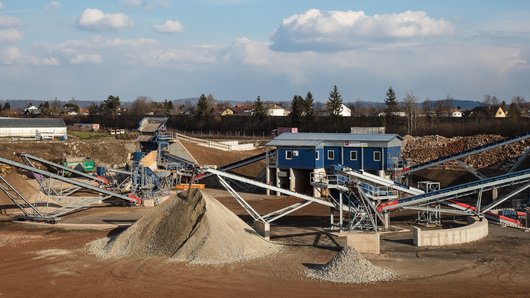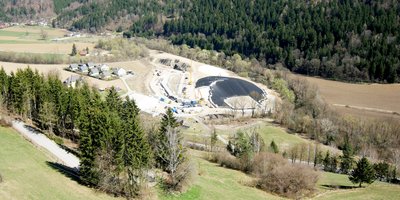
a single source
Remediation of Contaminated Site K20 in Brückl
The remediation of Contaminated Site K20 in the Carinthian market town of Brückl gave PORR the opportunity to demonstrate its diverse portfolio of services.
PORR Umwelttechnik cleared the site, erected parts of the groundwater cleaning system and soil gas extraction system. PORR Bau was commissioned to construct the surrounding diaphragm cut-off wall, while IAT was tasked with installing a surface seal.
-
EmployerDonau Chemie Aktiengesellschaft
-
ContractorPORR Umwelttechnik GmbH in einer ARGE, PORR Bau GmbH, IAT GmbH
-
Project typeEnvironmental engineering, Site-remediation
-
Project scopeComplete remediation of a contaminated site including recultivation of the upper surface and erection of parts of a soil gas extraction system and a groundwater cleaning system, as well as a cut-off diaphragm wall
-
Order volumeEUR 30 million
-
Construction start10/2011
-
Construction end06/2018
Background
Contaminated Site K20 in Brückl, in the district of St. Veit an der Glan, is a former landfill site owned by Donau Chemie AG. It was filled with waste materials from 1926 to 1981. Over the decades, ash, slag, refuse, carbide lime and coal were stored here as secondary constituents along with building rubble and excavated material. In those days, there were no technical methods by which to protect the groundwater. When the site ceased to be used for storage, the entire landfill was covered with soil. According to the Environment Agency Austria, the depth of this covering layer varies between 0.95m for Lime Disposal Site I (southern section) and 3.5m for Lime Disposal Site II (northern section). In total, some 230,000m³ of waste was deposited here, of which about 80,000m³ is heavily contaminated with chlorinated hydrocarbons (CHCs). Due to the material characteristics of CHCs, the Environment Agency Austria considers the pollutant potential to be extremely high. As a result, the contaminated site was graded Priority Class 1 in 2003, meaning that remediation measures were urgently required.
In Brückl we were able to offer and implement all services along the value chain.
The project: Remediation through removal
Measures to secure the site have been implemented since 1995, including gradual erection and operation of soil gas extraction gauges including a soil gas purification system and continuously running evidence-protection measures. Work to clear Contaminated Site K20 then started in autumn 2011. The plan was to process, dispose of or treat all backfill material. In the course of the call for tenders according to Austrian procurement law, Lot 1 was won by the Joint Venture (ARGE) for Contaminated Site K20. Following the discovery of hexachlorobenzene in November 2014, including in
foodstuffs produced in the vicinity of the cement works commissioned to process the contaminated lime sludge, work to clear the site was halted. A Europe-wide call for tenders was issued by Donau Chemie AG in order to award a new contract for transport and treatment of the contaminated lime sludge, stating that “project security could not be provided in legal, technical, scheduling or economic terms for the continuation of the clearance”. The authorities subsequently issued a further assessment defining the safeguard measures over several phases.
Remediation phases: Safeguard measures from 2016
Instead of clearing the site as originally planned, a four-phase plan was created to implement structural safeguarding. Preliminary work was carried out in Phase 0, while Phase Ia saw the surface layer sealed up. This phase also involved boring holes for soil gas extraction. Phase Ib included installation of an activated carbon filter system to purify the extracted soil gas. In the final phase – groundwater conservation – construction work headed deeper: the site required a surrounding cut-off wall, a groundwater cleaning system, several groundwater wells within the seal as well as monitoring and control systems both within and outside of the seal. In 2016, a new partial call for tenders was issued by Donau Chemie AG for the safeguard measures in the project. The contract was awarded to PORR Bau GmbH, Specialist Civil Engineering department and IAT GmbH.
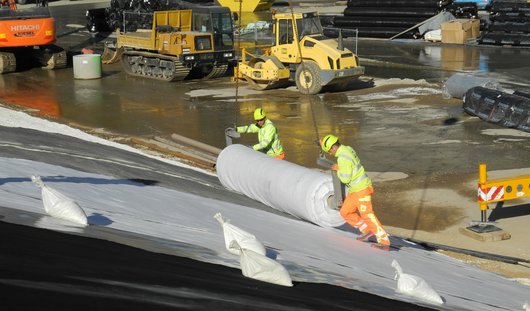

Phase 0: Preliminary work
Phase 0 comprised boring into the ground for research and investigation as well as installation of 26 soil gas probes, deconstruction of storage boxes and the manipulation area, and also laying water pipes and a sewage canal.
Phase Ia: Sealing the surface
The active multi-functional surface seal was implemented by IAT GmbH. It is composed of seven different layers applied on top of one another, with each fulfilling different tasks. On the one hand, any volatile pollutants must be stopped and dissipated; conversely, no moisture from the outside can be permitted to enter the stored waste in order to prevent pollutants from washing out. The innovative system, which was jointly developed by GWU Geologie-Wasser Umwelt GmbH (the designer commissioned by Donau Chemie AG), IAT GmbH and Huesker Synthetic GmbH, is composed of a calcium bentonite filter, an activated carbon filter, an LDPE (low-density polyethylene) membrane with an integrated CHC-proof aluminium layer and a hollow-nub drainage element with filter fleece applied on one side. Geogrids were then installed in to layers to stabilise the scope and prevent slippage. The uniqueness of the seal’s design, as well as the complexity of its composition, are particularly impressive.
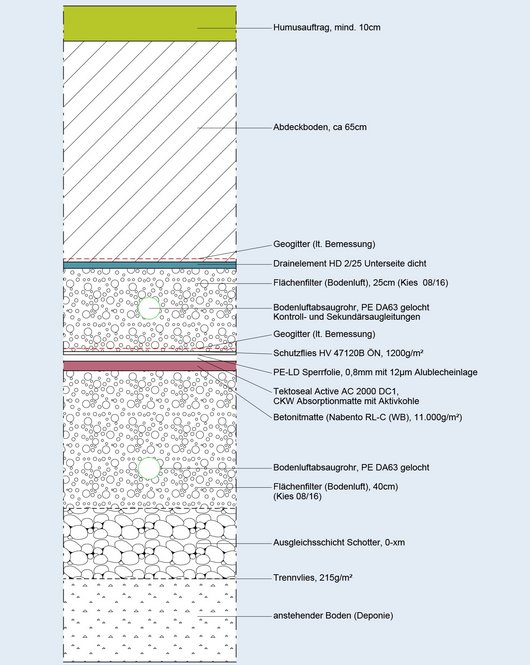

Phase Ib: Soil gas extraction
Every hour, some 640m³ of gas is extracted and directed to a purification system with the help of 60 vacuum pumps, 26 vertical soil air probes and a surface covering the entire surface filter. The same pumps extract the gas from the subsoil and transport it to be purified by an activated carbon filter. The system measures 2.45 x 2.60 x 5.90m, and ultimately transports the clean gas via a collection line with a diameter of 200mm to the 15m tall vent stack. In order to identify the optimal location for the stack, Donau Chemie AG tasked the TU Graz with developing a local dispersion model for the exhaust gas.
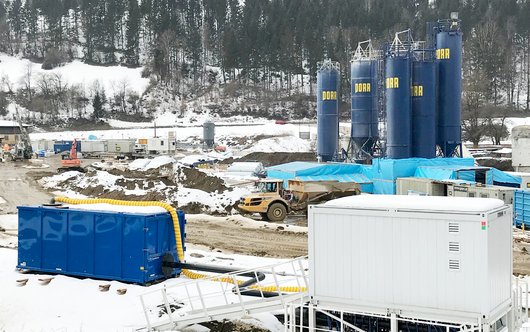

Phase II: Groundwater conservation
A three-dimensional hydraulic groundwater model was developed (Isar Consult) to optimise the volume of groundwater extracted in accordance with the depth of the required cut-off wall. Polluted water is extracted from dewatering wells and purified in two stages using special activated carbon. The system was designed and supplied by Donau Carbon (Frankfurt) and has a throughput of 224m³/h. In total, 2 x 5 silos were installed with 90t of activated carbon. The first stage involves purifying the water to the quality of drinking water while the second serves as a safeguard, undertaking the cleaning function if the activated carbon in the first stage needs to be replaced. Four absorption wells and eight wells outside the cut-off wall were also installed along the Gurk river. To monitor the efficacy of the hydraulic safeguard measures, an additional 20 gauges were drilled and installed along the entire cut-off wall – in each case with one inside and one outside the wall. This makes it possible to monitor the permanent reduction in the groundwater level within the cut-off wall.
The surrounding diaphragm cut-off wall
The cut-off wall was predominantly installed as a slurry wall of 60cm and 80cm thick, and also as a jet stream cut-off wall in places. The maximum depth of the diaphragm wall is 33m. The depth of the centre of the diaphragm wall is 26m. The confined spatial conditions along the Gurk river presented a particular challenge when constructing the diaphragm wall. In some places, the available working area was barely wider than the cable excavator’s chassis.
As a result, almost 400 running metres of the cut-off wall had to be slotted between the crawler tracks. Furthermore, for structural reasons heavy diaphragm wall equipment could not be used along an existing old sewer wall in the drainage zone of a powerhouse generating energy from hydropower. As a result, this section of the cut-off wall was implemented as a jet stream cut-off wall.
To ensure no pressure was applied to the existing old concrete wall, a cut-off wall of up to 16.5m deep, 14.5m deep at its centre, was installed with semi-circular columns. State-of-the-art measurement and device technology ensured that the jet stream was configured correctly, thereby ensuring successful construction of the jet stream cut-off wall. A total of 20 deep wells were installed within the cut-off wall with a depth of up to 30m. These will be used from August 2018 onwards to extract polluted groundwater to operate the cleaning system.
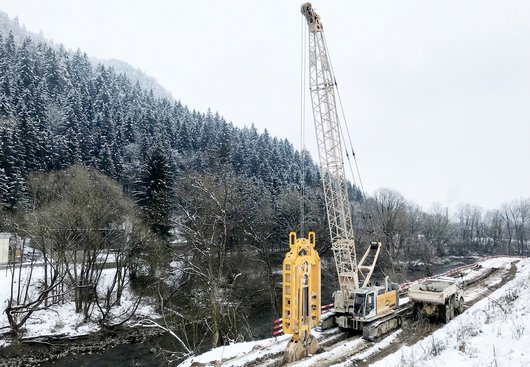

Technical data
-
Slurry wall20.000m²
-
Jet stream cut-off wall1.100m²
-
Subsurface air suction640m³/h
-
Groundwater conservation224m³/h
-
Landfill excavation120.000m³ respectively 150.000t
-
I. Lime sludge100.000t
-
II. Different fractions50.000t
Summary
The project to remediate Contaminated Site K20 emphatically proves that teamwork is more than just a catchphrase at PORR – it is part of the company’s practice. All work to secure the site both completely and permanently was completed in tandem with no significant loss of time: much of the work was carried out almost simultaneously. For instance, if profiling work was carried out on a given day, a corresponding section of the area would be covered the very next day. Thanks to the excellent cooperation throughout the PORR Group and the commitment shown by all involved, the project was successfully implemented to the client’s full satisfaction.

